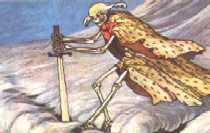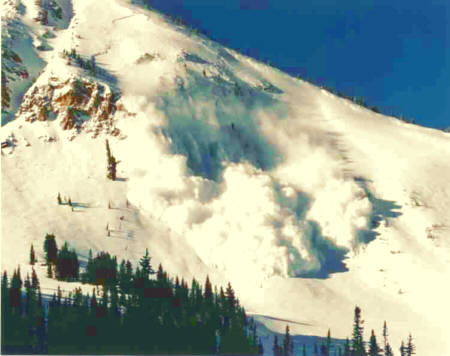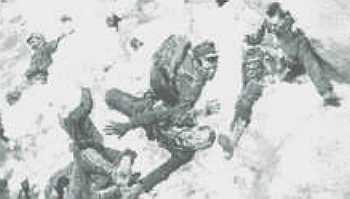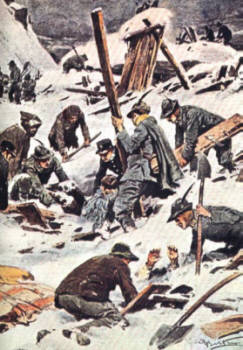


The Grim Reaper |
By
|
|||||||
Valanghe! - Avalanche! - Lawine! The most frightening enemy was nature itself….entire platoons were hit, smothered, buried without a trace, without a cry, with no other sound than the one made by the gigantic white mass itself. -Paolo Monelli  Avalanches, the sudden and often massive release of mountainside snow, are amongst the greatest destructive forces in nature. The hunters, smugglers and climbing guides of the European Alps have known and avoided this deadly phenomenon by staying out of the mountains in winter. The natives live where "the white death" is least found. For centuries villages have been constructed below natural barriers of trees and rock outcroppings. Covered roads (and later railroads) were built, all to protect them from this snowy wrath. During the Great War the menfolk of the Austrian and Italian Alps found themselves in the worst of predicaments, at war in the most dangerous of places, the wintry snowbound Alps. These highlanders turned soldier would die in their tens of thousands from what they knew, avalanche and cold, as well as suffering the most common fate of millions of men in these four terrible years, machine gun and artillery fire. The concepts, tactical and logistically, of alpine warfare were all new and unexpected. Specialized regiments of mountain troops had been developed by all nations of the Alps, but few had been tested in alpine combat. Victory demands the high ground, and in these endless mountain ranges the high ground is a mighty consideration When the weather was fine, no position was safe from the enemy's view. Due to the complex geography of the area there was always an enemy position which was higher or which dominated the access path or looked to the rear of the opponents position. -Francesco Davini Mountains, at any time of year, are dangerous -- lightning, high wind, rock fall, extreme cold, crevasse and cliff. In war, the dangers take a quantum leap. Movement, medical evacuation and resupply up steep slopes, often where even mules cannot go, involves enormous exertion of energy. Observation in the mountains is almost unlimited…. or can instantly become zero, for days. Any built-up stone barricade can become a fatal trap. Bullet, grenade or artillery casualties increase with ricochet and splintering rock; there is no soft Flanders loam to absorb the concussion and fragments. Thirst must be considered as well;: water is locked up most of the year in winter ice or lost in super-permeable soil and impassable summer torrents. But it was the avalanche alone, however, that would account for a third of the total combatants killed in the higher, western half of the Alpine front. On this Hochgebirgsfront another third would die of cold related injuries, again reminding men of nature's cruel impartial power. [1] The other third would die in actual combat, mostly in summer operations.
Most of the men in the [Italian] trenches were very young, thinly clad and feeling the cold intensely, and they had been left in the line for a long period without relief. Many of them were weeping and some had ice on their faces: the conducting officer said that three or four of them were frozen to death nightly. As winter was coming on fast and conditions in the Austrian ranks, higher in the mountains and with the Alpine hinterland behind them, were much worse. - Lt.Colonel Pitt-Taylor During the three-year war in the Austro-Italian Alps at least 60,000 soldiers died in avalanches. [This conservative statistic comes from the research of Heinz von Lichem, in his outstanding three-volume study Gebirgskrieg 1915-1918] Ten thousand died from avalanches in the "lesser" ranges of the eastern half of the high front -- the Carnic and Julian Alps.[2] In the "high" Alps to the west, the Ortler and Adamello groups, the Dolomites, avalanches claimed 50,000 lives. [3] To put these casualties in perspective, a total of 25,000 troops were killed by poison gas on this war's Western front in Belgium and France. Gas killed an additional 7,000 men on the Austro-Italian front, the greater part on the plain and plateau between the Isonzo and Piave rivers. [Gas is not very effective in the cold windy atmosphere of mountains.]  Apparently Precarious Outposts Safe from AvalanchesAvalanches come in two basic forms, loose powdery slides and solid "slab" avalanches. Both types occur on the most common type of terrain in mountains, open 30 to 60 degree slopes. The mountains need not be towering crags to experience avalanches, the rugged Trentino Altopiano can attest to that. Higher mountains generally receive greater snowfall and naturally are less forested. Trees are less prone to slides, and can be considered a natural barrier, or grow where slides least occur. It is an avalanche's speed and mass that destroys, millions of cubic meters of snow rushing at speeds of up to 120 mph [200 kph]. The wind blast alone, at the front and edge of powdery slides, will knock down buildings, trees and people. In the Alps, this aspect of "the white death" is called "the sigh of the avalanche." Upon completion, the slide's snow will set up as hard and dense as concrete due to the friction and force. Victims are killed instantly by crushing and debris or will succumb to suffocation and exposure within an hour. Rescuers, if they are present, cannot hear cries for help, but from below every sound is magnified. This author was told in avalanche training with the Alpini forces of one incident during La Grande Guerra, where trapped soldiers fired off weapons to alert their rescuers. Upon release, those trapped mentioned their shooting, the soldiers above said they had heard nothing. Avalanche prediction and rescue has only recently become reliable, with radio-rescue beacons and the science of mountain weather and snow. It is now ski resorts that worry about their customers, not Landeschutzen or Alpini - who had no alternative but to "hold the line" on the worst of terrain and positions or send patrols into areas of known natural danger. Avalanches are caused by sudden heavy accumulations of snow, wind-formed cornices or rapid changes in weather conditions. Thawing and refreezing causes unstable, sliding layers of snow to form. They are set off or "triggered" by overloading, shearing, sunshine and vibration. These events can be natural or spontaneous or manmade. Alpine legends tell of voices, cowbells, yodeling, even singing (of unholy songs) as triggers. [4] The dangers of avalanches in modern warfare are obvious. A company of infantry crossing snow covered slopes or a ski patrol above them will start a disaster. The vibrations of machinery are enough to trigger a slide, let alone the explosions of artillery or machine gun fire. It has been said that opposing forces deliberately set off bombs, or fired artillery over columns of troops and transport to cause avalanches during WWI. This author finds these accounts unbelievable fiction or modern exaggerations for several reasons. The Alpini I knew said they had never heard these tales. "This sounds like Hollywood….perhaps in some other war, but we could never do such a thing," I was told. All "reports" of these deliberate avalanches seem to come from post-World Wat II studies about avalanches, not accounts of alpine warfare in the Great War. Not that I have read every tale of the Italian front, but nothing I have yet come across mentions this peculiar utilization of nature  A Ski Patrol Alert for Avalanche DangerA final reason to discount the idea of deliberately set avalanches is found in the live-and-let-live attitudes of the soldiers of the Great War towards their adversaries, especially on the front line. This factor would seem likely to be greater on the Alpine front. For generations these Austrians and Italians had been meeting frequently on summit and pass, at markets and weddings. Would the men of the Alps knowingly have tried to bury their neighbors alive? There are, however, stories passed down of cease-fires called after avalanches, with both sides assisting in rescue efforts, that seem more revealing of the soldiers true feelings on the matter. [6]
Omnipotent God, you rule all the elements, save us from the relentless cold, from the swirling blizzard, from the rush of the avalanche; Excerpt from The Prayer of the Alpino Survival in the high Alps would entail applying a great many methods, from locating the barracks men lived in, to meticulous planning of routes taken on attack or patrol, to the careful consideration of snow and weather conditions. Roofs could be reinforced to survive minor slides, but the best safety came from burrowing under glacial ice or into mountain rock; or incredibly, building on or below the steepest of slopes, where snow does not accumulate. Patrols could cross danger areas one man at a time, with 25-meter intervals and ropes, but larger units of Kaiserjager or Alpini had less choice in tactical movements or during the attack. Two of the worst incidents of avalanche on the Alpine front occurred in 1916, when both armies were still adapting to mountain warfare and survival above the timberline. On December 13th catastrophe struck the Austrian barracks below the Gran Poz summit of Monte Marmolada. This encampment had rock cliffs to shield from direct fire, and was out of high-angle [mortar] range. But these defenses from human violence could not protect them from the mountain itself, despite the "city under the ice." Two hundred thousand tons [1 million cubic meters] of snow and ice buried over 500 men. Only 40 bodies were recovered of the estimated 300 who perished. The snow did not cease. [7] Wind and accumulation made the conditions critical, and on the 17th of December the nightmare began. During the next two days, avalanches would take the lives of 9,000 to 10,000 Italian and Austrian soldiers. Communication lines, fixed ropes and climbing ladders were swept away, as were entire companies and batteries of men, guns and mules. In spring their remains were found by the ravens. [A photo in the Roana museum of just such matters is forever in my mind.]  Huge and mighty forms, that do not live
|
||||||||
To find other features on La Grande Guerra visit our |
Membership Information  Click on Icon |
For further information on the events of 1914-1918
visit the homepage of |
Michael E. Hanlon (medwardh@hotmail.com) regarding content,
or toLeo Benedetti (leoben@silcon.com) regarding form and function.
Original artwork & copy; © 1998-2000, The Great War Society


